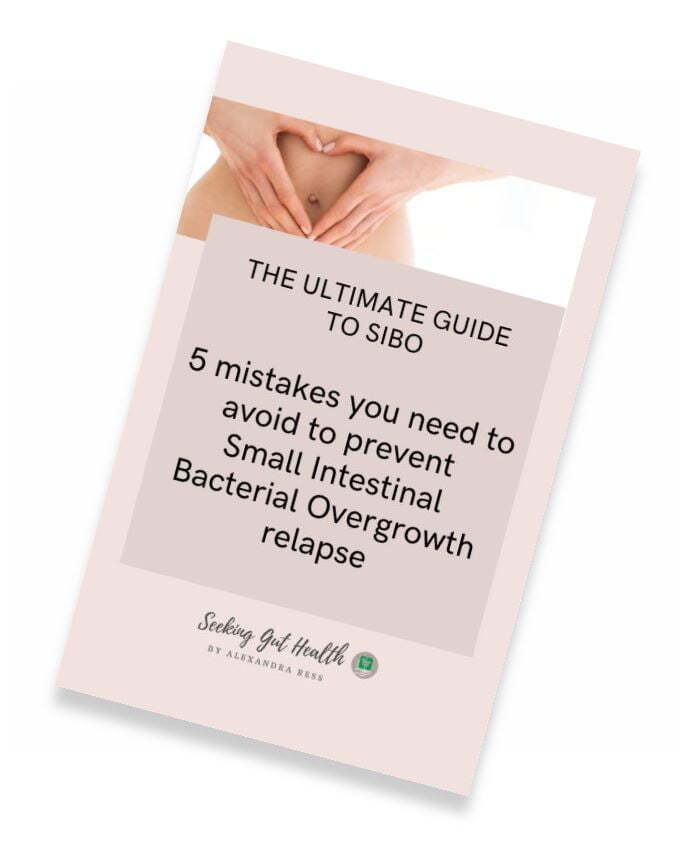
What is SIBO & SIBO testing?
First of all, what is SIBO? SIBO stands for Small Intestinal Bacterial Overgrowth. It is defined as the presence of excessive bacteria in the small intestine. The problem is that there are too much bacteria and/or the wrong type of bacteria present in the wrong place.
Symptoms can be excess/trapped gas, bloating, diarrhea and/or constipation, abdominal pain or cramping, food sensitivities, chronic fatigue, brain fog, and the list goes on. (1)(2)
Before getting tested
Before getting to SIBO testing, many people try different methods to relieve their symptoms. These approaches may include lifestyle changes (e.g., reducing sugar/junk and processed food consumption; stress; getting more sleep) or eating more fiber, prebiotic foods, and herbs. However, if these changes don’t bring the expected results or make the current symptoms worsen, then it might be time to visit the GI doctor to have some tests.
Although having the symptoms mentioned above doesn’t mean that you have 100% SIBO. It is crucial to rule out other diseases (like endometriosis, Crohn’s/ Colitis) and get a proper diagnosis by your healthcare practitioner. There can be many different diseases, which could cause the same symptoms.
Suppose you have already been diagnosed with IBS (Irritable Bowel Syndrome). In that case, it is definitely worth getting SIBO testing because, according to a study, up to 84% of patients with IBS actually have SIBO. (3)
It may also happen that a person thought SIBO was causing the symptoms, but then the culprit turned out to be Celiac disease. (4) If you start using an antimicrobial treatment for assumed SIBO without any proper diagnoses, then it may cause more harm than good. So testing is essential, which can help define the treatment plan.
SIBO testing method #1: SIBO breath test
The three-hour lactulose or glucose breath test is generally used for diagnosing SIBO, which detects the different types of gases that bacteria produce in the small intestine. It checks for hydrogen and methane gas. (5) There is now a new test available in the US: the TrioSmart test that can detect the third type of gas: hydrogen sulfide. (6) I wrote about the different types of SIBO.
The bacteria in our intestines ferment specific carbohydrates, and they produce gases as a byproduct. The breath test involves drinking a sugar solution (lactulose or glucose, a type of carbohydrate) that feeds the bacteria in the gut, and they start making gases. Then these gases are absorbed in the intestines and get into our blood, from where the gases are delivered to our lungs and exhaled in our breath. That is what the breath test intended to capture.
The breath test is done for 3 hours, while breath samples are taken at 20-minute intervals. The first two hours represent the small intestine, and the last hour usually the large intestine. Measuring the level of those gases is also important to determine how severe the bacterial overgrowth is and what treatment would suit the best.
Be aware that a prep diet is required to be followed before SIBO testing. It involves following a low-fiber diet and fasting for 14 hours. (When you order a test, you should receive instruction on the prep diet). (7)
A hydrogen breath test is also used for testing carbohydrate malabsorption issues when dietary sugars are not absorbed well, such as lactose (sugar in milk), fructose (sugar in fruit) or sorbitol, sucrose. (8)
Imagine taking back control of your body and living bloat-free. Download your free guide and learn the 5 MISTAKES you need to AVOID TO PREVENT SMALL INTESTINAL BACTERIAL OVERGROWTH RELAPSE.
Grab your copy today!
Can you trust the SIBO breath tests?
While the breath test is considered the most practical SIBO testing method, it certainly has its limitations.
When checking a meta-analysis regarding the breath test accuracy, it showed that lactulose substrate might provide a higher number of false-positive results than glucose test. Glucose breath test seems to work better than lactulose breath test for diagnosing SIBO. It seems glucose testing has better sensitivity and specificity. (9) (10) In this case, clinicians may need to evaluate more carefully the results before giving out a diagnosis, and would worth doing a test for both type of substrates.
Other problems can be:
• the missing consensus on the interpretation of breath test results
• Individual’s motility can influence the test results – transit time may differ from person to person (11)
Other types of tests
If you have IBS-D or IBS-M/SIBO-D, you experience mainly diarrhea symptoms; then an IBS-SMART test is available to diagnose post-infectious IBS (PI-IBS). It is a blood test that looks for the markers of food poisoning (one of the leading causes of SIBO), as a result of which auto-antibodies form in a lot of people and start an auto-immune process. The antibodies measured in the blood are anti-CdtB toxin and anti-vinculin. These antibodies can attack the nerves of the gut and impair the cleaning wave, the Migrating Motor Complex. (12)(13)
What tests are not suitable to diagnose SIBO?
- Stool tests because the results represent mainly the end of the large intestine, although they might indicate some issues in the small intestine but cannot diagnose SIBO. Overgrowth of bacteria in a stool can show dysbiosis.
- Organic Acid Tests (OAT) because check the urine for byproducts of yeast or bacteria in the small intestine, which can be very useful but cannot tell whether your SIBO is hydrogen/ hydrogen-sulfide or methane-dominant. (14)
Conclusions
Using SIBO testing (a breath test) has its advantages and disadvantages, but it can still be the most practical approach to diagnosing SIBO. Metanalysis showed that a glucose breath test might provide a more accurate diagnosis than a lactulose breath test. Having a SIBO diagnosis can be crucial as it can define the best treatment options (each type of gas requires different strategies).
Bear in mind that diagnosing SIBO might be just the first step because it will not tell you what caused SIBO in the first place. However, finding the underlying cause is crucial to prevent relapsing.
If you have questions regarding SIBO or need help finding out your root cause and support on your healing journey, then feel free to book a free consultation call!
* This post is only for informational purposes and not meant to diagnose or treat any disease. I advise consulting with your healthcare practitioner regarding any treatment options or dietary changes.
- Dukowicz, A. C., Lacy, B. E., & Levine, G. M. (2007). Small intestinal bacterial overgrowth: a comprehensive review. Gastroenterology & hepatology, 3(2), 112–122.
- Bures, J., Cyrany, J., Kohoutova, D., Förstl, M., Rejchrt, S., Kvetina, J., Vorisek, V., & Kopacova, M. (2010). Small intestinal bacterial overgrowth syndrome. World journal of gastroenterology, 16(24), 2978–2990. doi.org/10.3748/wjg.v16.i24.2978
- Ghoshal, U. C., Shukla, R., & Ghoshal, U. (2017). Small Intestinal Bacterial Overgrowth and Irritable Bowel Syndrome: A Bridge between Functional Organic Dichotomy. Gut and liver, 11(2), 196–208. doi.org/10.5009/gnl16126
- Atay, O. (2021). 49- Other Diseases of the Small Intestine and Colon. (J. S. Robert Wyllie, Ed.) Pediatric Gastrointestinal and Liver Disease (Sixth Edition), Pages 534-540.e3. doi:doi.org/10.1016/B978-0-323-67293-1.00049-9.
- Simrén, M., & Stotzer, P. O. (2006). Use and abuse of hydrogen breath tests. Gut, 55(3), 297–303.doi.org/10.1136/gut.2005.075127
- (TrioSmart, n.d.) https://www.triosmartbreath.com/
- Camilleri, M., & Szarka, L. A. (2021). Every Breath Test You Take: Practical Advice on Breath Testing Used to Detect Small Intestinal Bacterial Overgrowth. Digestive diseases and sciences, 66(2), 331–333. doi.org/10.1007/s10620-020-06776-4
- Rana, S. V., & Malik, A. (2014). Hydrogen breath tests in gastrointestinal diseases. Indian journal of clinical biochemistry : IJCB, 29(4), 398–405. doi.org/10.1007/s12291-014-0426-4
- Losurdo, G., Leandro, G., Ierardi, E., Perri, F., Barone, M., Principi, M., & Leo, A. D. (2020). Breath Tests for the Non-invasive Diagnosis of Small Intestinal Bacterial Overgrowth: A Systematic Review With Meta-analysis. Journal of neurogastroenterology and motility, 26(1), 16–28. doi.org/10.5056/jnm19113
- Rana, S. V., Sharma, S., Kaur, J., Sinha, S. K., & Singh, K. (2012). Comparison of lactulose and glucose breath test for diagnosis of small intestinal bacterial overgrowth in patients with irritable bowel syndrome. Digestion, 85(3), 243–247. doi.org/10.1159/000336174
- Simrén, M., & Stotzer, P. O. (2006). Use and abuse of hydrogen breath tests. Gut, 55(3), 297–303. doi.org/10.1136/gut.2005.075127
- Definitive tests for irritable bowel syndrome developed at Cedars-Sinai. Cedars-Sinai website. https://www.cedars-sinai.org/newsroom/definitive-tests-for-irritable-bowel-syndrome-developed-at-cedars-sinai/. Published May 14, 2015. Accessed June 21, 2019.
- Morales W, Rezaie A, Weitsman S, Barlow G, Pimentel M. Sa1680 — second generation anti-CdtB and anti-vinculin testing produces greater diagnostic accuracy for IBS-D compared to IBD. Gastroenterology. 2019;156(6 Suppl 1):S-364.
- Lord, R. S., & Bralley, J. A. (2008). Clinical applications of urinary organic acids. Part 2. Dysbiosis markers. Alternative medicine review : a journal of clinical therapeutic, 13(4), 292–306.

Alexandra is a Functional Medicine Certified Health Coach & Holistic Nutritionist specializing in IBS, SIBO, and Gut Health. She helps her clients identify the root causes of their chronic gut issues with functional testing, supporting their bodies holistically and implementing the necessary lifestyle changes long-term to regain control of their bodies and enjoy food freedom. Book your FREE SIBO Assessment call now >>>

